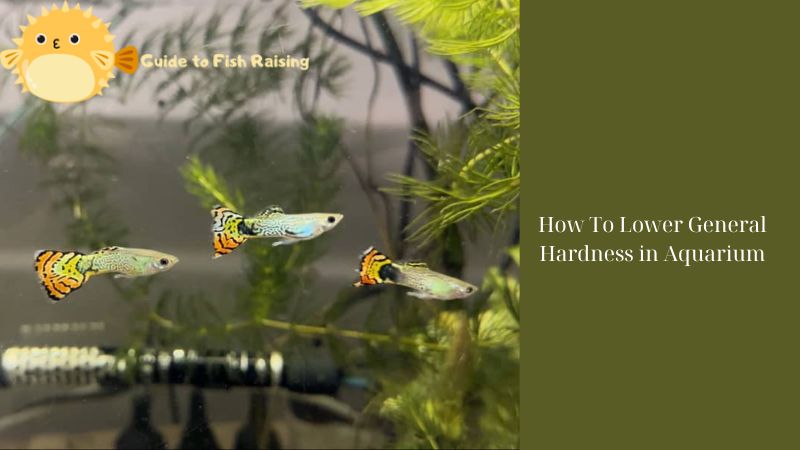“How to lower general hardness in aquarium” is an important but often overlooked factor in setting up and maintaining an aquarium. Most aquarists are familiar with testing parameters such as ammonia, nitrate and nitrite. However, water hardness – an important indicator that affects the health of aquatic organisms – is often forgotten, especially by beginners. In this article, fishtankenthusiast.com will answer questions related to water hardness in aquariums, from definitions to how to measure and adjust.
Hardness of Aquarium Water
Water hardness refers to the amount of minerals dissolved in the water, mainly calcium and magnesium. Natural water has variable hardness depending on the geology of the area, such as limestone or dolomite. Tap water is often hard and may require softening for some freshwater aquariums. Water hardness directly affects the health of fish and invertebrates, supporting metabolism and bone growth.
Why is it necessary to adjust aquarium water hardness?
Ensure ideal parameters for fish species: Each fish species originates from different water environments with specific water parameters. Although captive-bred fish often adapt to new water environments, if you raise wild fish, adjusting water hardness to their native environment is necessary to ensure health and growth.
For breeding purposes: Some fish, like guppies and molly fish, grow better in hard water because they need calcium to reproduce. Conversely, some fish species, such as male fish (Mikrogeophagus ramirezi), require soft water for their eggs to develop normally.
To grow aquatic plants: Although most aquatic plants grow well in hard or soft water, some plants like Vallisneria require hard water to grow.
For the safety of tank inhabitants: Water hardness directly affects pH. Hard water has a high pH and soft water has a low pH. Minerals in hard water act as buffers, helping to stabilize pH and protect the aquarium’s ecosystem. In areas with soft tap water, carbonation supplementation is necessary to prevent large fluctuations in pH, protecting fish health.

How to Measure Water Hardness in an Aquarium
- There are two main parameters to measure water hardness in aquariums: GH (Total Hardness) and KH (Carbonate Hardness).
- GH (Total Hardness): Measures the amount of dissolved minerals, mainly calcium and magnesium, in water.
- KH (Carbonate Hardness): Measures the buffering capacity of water, helping to prevent sudden changes in pH. Carbonate and bicarbonate in water help neutralize acid and stabilize pH.
4 Reasons for Adjusting Water Hardness
- Ensuring an Ideal Environment for Specific Species: Each fish species has different requirements for water hardness. Adjusting the firmness to match your fish’s natural environment will help them grow better and reduce stress.
- Supports Reproduction: Some fish species need hard or soft water to reproduce effectively. Live-bearing fish like guppies need hard water to supplement calcium for the fry’s growth.
- Growing Aquatic Plants: Most aquatic plants grow well in water that is moderately hard to hard. However, some specific species may require hardiness adjustments for optimal growth.
- Maintain Stability of Aquarium Ecosystem: Water hardness directly affects pH, and stability of water parameters is the most important thing to maintain a healthy living environment for aquatic organisms. aquatic animals.
How To Lower General Hardness in Aquarium
Use RO/DI system
A reverse osmosis deionization system purifies every particle in the water that passes through it, even removing minerals. By the end of the process, it will produce nearly pure H2O, giving you the softest water possible. However, purified water like this is actually not good for any fish because they need minerals to survive, so fish farmers will add minerals to RO water before adding it to the aquarium. Some people can even mix it with regular tap water to achieve the desired water hardness.
Check out SL-Aqua’s GH and KH water treatment products to help replenish essential minerals removed from RO/DI systems.
Add soil to the fish tank
Planted tank substrates like Controsoil will buffer the water and keep the water’s pH below 7, reducing water hardness. It will also provide all the nutrients the plant needs to grow!
Add driftwood
Driftwood contains tannins that are released over time as it sinks underwater. These tannins will decrease pH and soften the water. When tannins are released into water, they can dye the water a brown color similar to tea. To avoid this, you can boil the driftwood before adding it to the aquarium. Boiling also ensures that it is sterilized and safe to place in the tank.
Add Other Tannin Sources
Other sources of tannins include: Catappa/Indian Almond leaves, alder cones and peat moss. Each of these will release tannins to help reduce pH and hardness. Learn more about using tannins in Blackwater Biotope – Tips & Tricks.
Water hardness is often overlooked in the aquarium hobby, but it is arguably an essential parameter for maintaining a stable and safe environment for your fish. Always remember that while there are ideal water parameters for your fish, stability is most important. Rapid changes in pH can be harmful to your fauna, so use caution when changing parameters.
Conclusion
Water hardness is an essential factor in maintaining a stable and safe environment for an aquarium. Even though there are ideal water parameters for your fish, the stability of the habitat is the most important thing. Adjusting water hardness will help you create a healthy and thriving aquarium. Hopefully this article provides you with useful information how to lower general hardness in aquarium.





